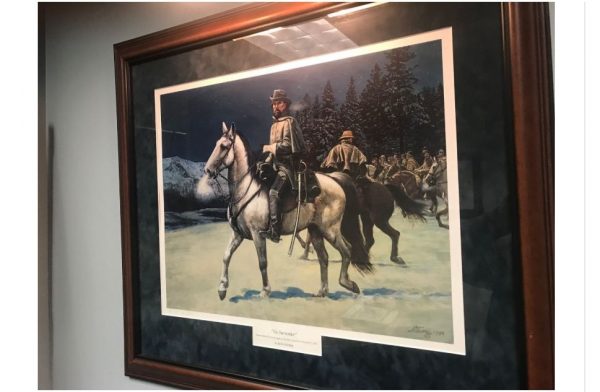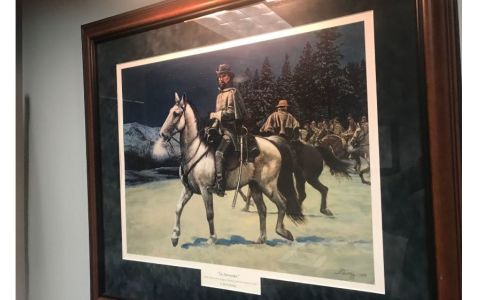
David Thomas Sr., deputy executive director of the Veteran Administration’s Office of Small and Disadvantaged Business Utilization, says he removed this painting from his office after a Washington Post reporter made him aware that its subject, Nathan Bedford Forrest, was a Confederate general and slave trader who served as the Ku Klux Klan’s first leader. (Courtesy of John Rigby) (Courtesy of John Rigby /Courtesy of John Rigby)
Department of Veterans Affairs staff members demanded last week that a high-ranking official remove from his office a painting titled “No Surrender,” which depicted a Confederate general atop a horse, riding across a snowy battlefield.
In a petition, workers explained that not only was the man featured in the painting a Confederate general, but he was none other than Maj. Gen. Nathan Bedford Forrest, a ruthless slave trader, the first grand wizard in the Ku Klux Klan and the man who led the Confederate forces in a bloody Civil War battle in 1864 that became known as the Fort Pillow Massacre.
The controversy over the painting led to two more questions: What is Fort Pillow? And what happened there?
The battle to regain Fort Pillow began April 12, 1864, when Forrest led 2,500 Confederate cavalry in an attack on the fort about 40 miles north of Memphis, according to by the National Park Service. The fort was held by Union troops — including 295 white soldiers and 262 “colored” soldiers — under the command of Maj. Lionel F. Booth.
The Confederates, including sharpshooters, unleashed a storm of bullets on the fort, killing Booth. Forrest demanded unconditional surrender. Although outnumbered by the Confederate soldiers, Maj. William F. Bradford, who had taken command of the Union troops, refused to surrender.
“Confederates renewed the attack, soon overran the fort, and drove the Federals down the river’s bluff into a deadly cross fire,” according to the Park Service.
As many as 300 Union soldiers — including 200 black soldiers — were killed. Many were shot point-blank in the head.

The photo, taken between 1861 and 1865, shows guns mounted along the perimeter of Fort Pillow. (Library of Congress)
Mack Leaming was the highest-ranking Union officer to survive the battle. His eyewitness account, written nearly 30 years later, on April 14, 1893, would stand as a testament to what happened at Fort Pillow.
“Our line broke and many of the troops threw down their muskets and rushed down the bluff towards the river, the rebels meanwhile keeping up a murderous fire,” Leaming wrote, according to the Gilder Lehrman Institute of American History, a nonprofit group dedicated to history education.
”Many of the colored soldiers, seeing that no quarters were to be given, madly leaped into the river, while the rebels stood on the banks or part way up the bluff, and shot at the heads of their victims.”
Leaming fell on the side of the bluff near the bank of the Mississippi River. “I could plainly see this firing and note the bullets striking the water around the black heads of the soldiers, until suddenly the muddy current became red and I saw another life sacrificed in the cause of the Union,” he wrote.
Then Leaming noticed a black soldier in the river, clinging to life. “Two confederate soldiers pulled him out,” Leaming recalled. “He seemed to be wounded and crawled on his hands and knees. Finely [sic] one of the confederate soldiers placed his revolver to the head of the colored soldier and killed him.”
Confederate soldiers pulled down the stars and stripes flag, Leaming wrote, “and hoisted the stars and bars.”

An 1864 photo shows officers of the 16th U.S. Colored Infantry Regiment atop Lookout Mountain, Tenn. Black units in the Civil War were commanded by white officers. (Library of Congress).
In May 1864, the New York Times received a letter from a naval officer describing the bloody scene at Fort Pillow and demanding the Union government retaliate.
“I write, because most of our crew are colored, and I feel personally interested in the retaliation which our Government may deal out to the rebels, when the fact of the merciless butchery is fully established,” Robert S. Critchell, an acting master’s mate, wrote to U.S. Rep. Henry Blow (R-Mo.).
He also detailed the how the “colored” troops had been “murdered” by the Confederate soldiers.
“I found many of the dead lying close along by the water’s edge, where they had evidently sought safety; they could not offer any resistance from the places where they were, in holes and cavilles along the banks,” Critchell wrote. “Most of them had two wounds. I saw several colored soldiers of the Sixth United States Artillery, with their eyes punched out with bayonets; many of them were shot twice and bayonetted also.”
Critchell was appalled by the gruesome scene of 70 black soldiers lying dead along the Mississippi River.
“Going up into the fort, I saw there bodies partially consumed by fire,” Critchell wrote. “Whether burned before or after death I cannot say, any way there were several companies of rebels in the fort while these bodies were burning, and they could have pulled them out of the fire had they chosen to do so.”
The “Fort Pillow Massacre” became a fervent rallying cry among Union troops, according to the National Park Service, “and cemented resolve to see the war through to its conclusion.”
–washingtonpost.com
###



